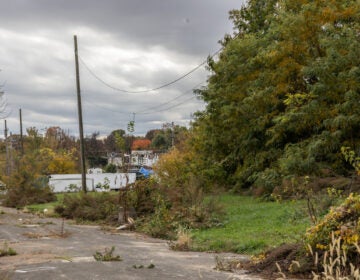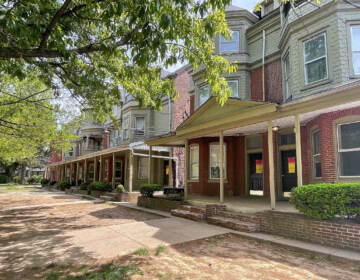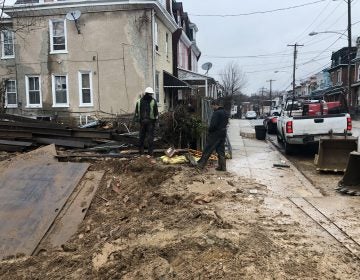Toronto’s Big Move
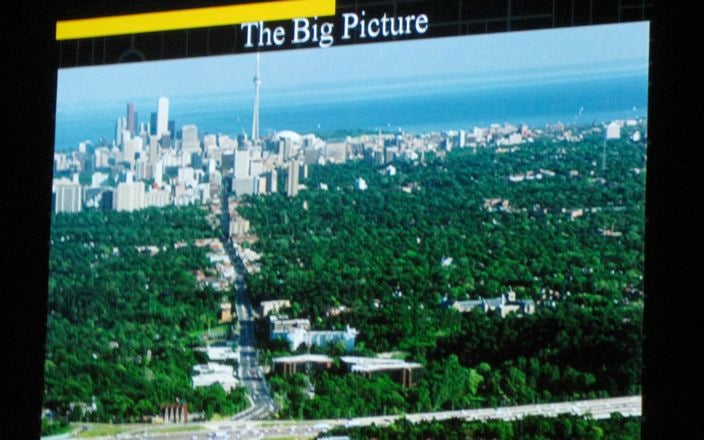
Feb. 08
By Thomas J. Walsh
For PlanPhilly
With an investment of more than $11 billion in transit infrastructure over the next two decades, two of the hallmarks of the current economic gloom will be partially dealt with simultaneously – healthcare (obesity rates, for starters) and dependence on peak oil.
For now, alas, we have to look north for this inspiration, to the city of Toronto – roughly the size of the Philadelphia region in terms of population. The provincial government of Ontario has already budgeted $744 million in “Quick Win” projects for the first of three phases of transit development that are planned through, and beyond, the year 2020 for its Metrolinx system.
Called “The Big Move,” and perhaps the very antithesis of Boston’s infamous “Big Dig,” the project for the Greater Toronto and Hamilton area is aimed at reducing the distance regional commuters drive by one-third; increasing sixfold the number of bike lanes and trails; cutting emissions from private cars by half; and initiating a single, integrated fare card for all transit trips, no matter the mode. And those are just the broad outlines.
“Transit is the only answer,” said Paul Bedford, Toronto’s planner emeritus and a member of the Metrolinx board of directors.
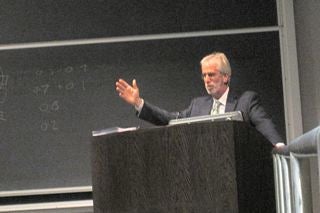
The plainspoken Bedford is currently retired from daily planning but teaches at the University of Toronto and at Ryerson University, and is still very much involved in the city’s future blueprints. He spoke at Penn’s School of Design Thursday night (Feb. 5) as part of a series of discussions from experts who have helped to create vision plans for cities and regions, held in conjunction with the school’s second-year planning studio. Students are creating vision plans for Philadelphia in 2040, incorporating aspects of globalization, the changing economy, environmental design, transportation challenges and the “city of neighborhoods” reputation that the city enjoys.
Toronto has that layered, neighborhood character, too, partially by recent design and partially by recent immigration patterns. However, unlike Philadelphia, Toronto has been growing, and not just because of the 1998 “amalgamation” of seven neighboring municipal entities (including Toronto, which used to be half the geographic size it is now) into one, much larger city. With an urban population of 2.6 million and pushing 7 million for the region, by 2030 it is expected that the Toronto-Hamilton area will have grown to 10 million people, surpassing Chicago in just the next two years.
“Unlike Vancouver, Toronto is basically flat,” Bedford said. “It is not a pretty place. It’s kind of gritty, with a kind of ‘raw urbanism’ that to me is part of the attraction. It’s an alphabet soup of humanity … with more than 100 languages spoken.”
Like Vancouver, though, it is tough to draw parallels with Philadelphia, even though Toronto is much more similar in size.
For better and for worse, it is not an American city, of course. Philly and Chicago, and their states of Pennsylvania and Illinois, have their historical share of corrupted city officials (one state more recent than another, perhaps). But what is one to make of Toronto’s “nonbinding referendum” vote from March 1997, in which the provincial government of Ontario’s amalgamation plan went down in flames, with 76 percent of voters opposing it? How does one explain the fact that the conservative party running the province at that time went ahead and did it anyway?
“After 1998, everything changed,” Bedford said, explaining with a shrug the “god-like” powers of the province. There is no such thing as “home rule” for major cities in Canada, he said, and provincial chieftains can even change the name of cities if they choose to do so.
Best to leave that as another lecture entirely, Bedford seemed to say, and dive into the changes that took place after 1998, when, he said, “it was incredibly difficult to get to work.”
Going Pamplona
After having to compete to keep his old job as the amalgamated city’s chief planner – with an enormous new job in front of him – Bedford was retained, but said he was at a point in his career where he could afford to throw himself boldly into streamlining seven different plans. He used those plans, totaling 35 pounds of documents, to dramatic effect in front of Toronto’s new city council, creating the 99-page “One City… One Vision… One Plan.”
“The new city council desperately wanted something to call their own,” he recalled, and the members were only too happy to have him take the risks. “I knew I would either get fired or retire. They said, ‘If he screws up, it’s his ass. If he succeeds, we all benefit.’”
Bedford got some laughs and a few gasps from students as he showed a slide of a bullfighter in midair, held aloft by the tip of a bull’s horn planted firmly in his genitals. “Often I feel like this is where planners are – just right there – just about to get screwed,” he said, graphically illustrating the political side of the young planners’ impending careers.
“Clearly, doing a citywide plan is very, very stressful. Don’t kid yourself. You gotta be sure you don’t end up in the position of this poor bullfighter.”
Part of his strategy was accommodating the media and “a very conscious decision to be all over the newspapers,” Bedford said. “It is critical to get that horsepower and energy to get out in front of 2.6 million people.”
“It is very important to be nice to journalists,” said this very intelligent, engaging, thoughtful, humorous, down-to-earth public servant. The insightful, precedent-setting city planner added that he made it a point of never failing to return reporters’ phone calls or missing a stated deadline.
The needle and the cleaver
In short, Bedford avoided the best of the bull, and many of his ideas took root, including the creation of four “protection designations” (for neighborhoods; apartment neighborhoods; parks and open spaces; and utility corridors) and four “growth designation areas” (mixed use; reinvestment; employment; and institutional). The streamlining efforts were often simple Planning 101 concepts, such as separating the vision of the official plan (general land use, transit and roads, housing and services, etc.) from official and precise zoning law, with its very specific land use guidelines, height limits, set-backs, parking standards, density limits and the like. In this, Philadelphians can find hope in the efforts of the Zoning Code Commission, now in the midst of a multi-year overhaul of the Quaker City’s dizzying and out-of-date zoning laws.
Toronto’s official plan, in effect as of September 2007, can be found here: http://www.toronto.ca/planning/official_plan/introduction.htm
Among its highlights, the plan:
• identifies where “new jobs and housing will be encouraged”
• “promotes growth that is less reliant on the private automobile” by “directing development to areas with good transit, while improving transit in growth areas”
• protects the character of Toronto’s neighborhoods
• protects the city’s “important employment districts,” and promotes architectural and environmental preservation
Sustainable development is emphasized, and the plan “seeks to ensure the social and environmental infrastructure is in place to serve Toronto’s present and future residents.”
Soon, the Philadelphia Planning Commission will seek to implement a new Design Review Committee, stressing the impact of sound design principles on the “public realm.” (Feb. 2 PlanPhilly story: http://www.planphilly.com/node/7091) That phrase appears in the highlights of Toronto’s plan, saying it “contains design policies to guide the physical form of development and public realm improvements.”
Changes to urban design can be subtle and gradual, and they can come via “urban acupuncture,” a term Bedford is fond of, defined as a pinpointed effort in certain strategic spots within a city, to relieve pressure and release energy in a relatively quick fashion.
But perhaps owing to his overall experience over the course of a decade that saw enormous changes to his city, with grand rewriting of short-term and long-term plans alike, Bedford is happy to endorse the use of a meat cleaver if appropriate. Take drive-through fast-food joints, for example.
“I hate them with a passion,” he said, saying they use a disproportionately large amount of space, are usually 24-hour operations and produce mountains of garbage. “They don’t belong in urban areas.”
These days in Toronto, you can only walk into a McDonald’s or any kind of take-out restaurant. The chain operators didn’t go down on this issue without a fight, but to make a not-so-long story short, Bedford successfully tied the downside of drive-throughs to a “map of the stability of the neighborhoods,” an argument that won the day at a very large hearing.
The PennPlanning series, “Philadelphia 2040 Studio: Models of City Transformation,” featured appearances earlier last week from Gil Kelley (planning director of Portland, Ore.) and Larry Beasley (former planning director of Vancouver, British Columbia). The Feb. 3 PlanPhilly coverage of their appearance is here: “Penn visions of Portland, Vancouver” http://www.planphilly.com/node/7183
Sitting near the front for all three presentations, listening attentively and talking with the presenters afterward, was Philly planning chief Alan Greenberger.
Contact the reporter at thomaswalsh1@gmail.com.
ON THE WEB:
Toronto Metrolinx: http://www.metrolinx.com/en/default.aspx (Home page), http://www.metrolinx.com/thebigmove/index.html (“The Big Move” page)
Toronto official city Web site: http://www.toronto.ca/
WHYY is your source for fact-based, in-depth journalism and information. As a nonprofit organization, we rely on financial support from readers like you. Please give today.




